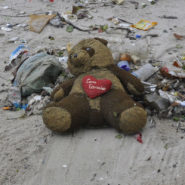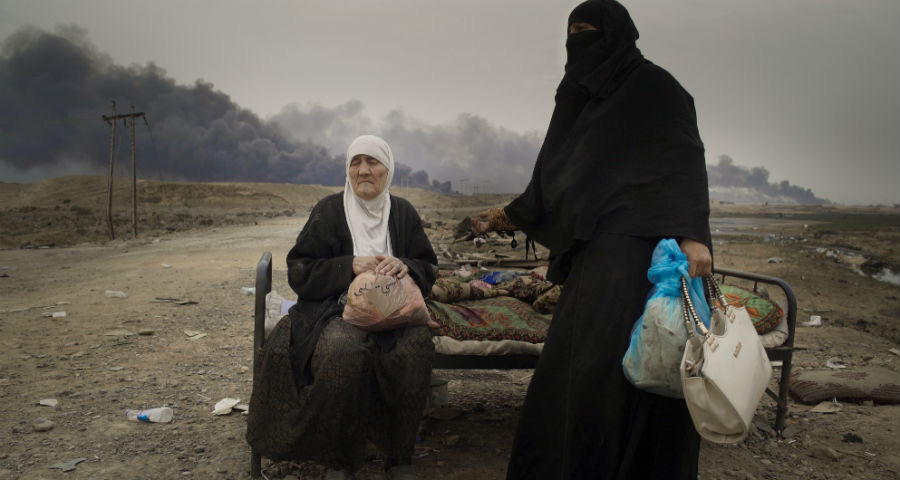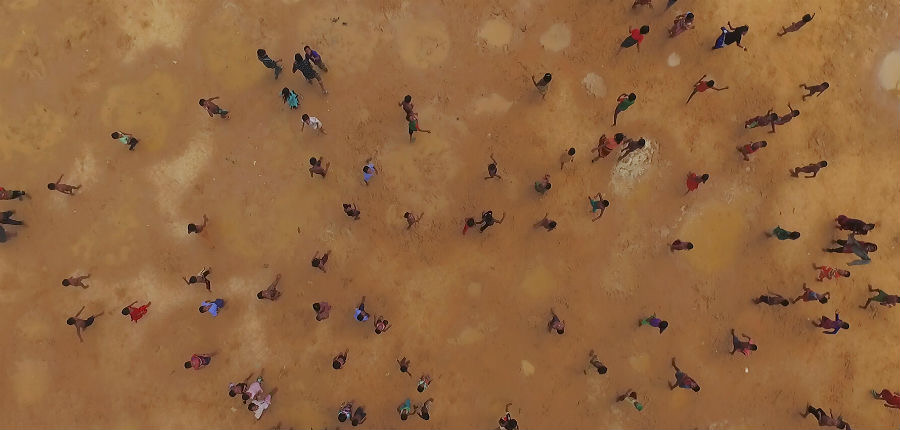
In Human Flow, Chinese artist, dissident, and director Ai Weiwei has turned his enormous energy and heart to chronicling a modern-day mass migration the like of which has not been seen for seventy years. More than sixty-five million men, women, and children, having been displaced by war, hunger, and persecution, forge a perilous path toward a better life. If the journey doesn’t kill them (more than seven thousand died en route in 2016), they may find their journey thwarted by impossible natural conditions, closed borders, and indifferent or hostile receiving countries.
Filmed in 2016 in twenty-three countries, the story of this massive wave of exiles–this human flow–washes over the viewer in an epic work as emotionally moving as it is visually stunning.

Refugees in Kenya, 2016. From HUMAN FLOW, an Amazon Studios release. Photo courtesy of Amazon Studios.
The film opens in Lesbos, Greece, a critical entry point to Europe for people fleeing conflict zones. Each boat arrives to cheers and excitement. Helping hands deliver weary travelers to shore.
Soon enough, though, the elation of reaching land gives way to the endless hardship and monotony of refugee life. Lacking sufficient food, water, shelter, clothing, or sanitary facilities, the new arrivals will huddle in wind-whipped tents, slog through oceans of mud, and pick their way through heaps of garbage. As they continue their trek, they will encounter razor wire and border control dogs, ennui and bureaucracy. No matter how many millions are settled in new countries, more millions follow in an exodus that will not be ending anytime soon.
As filming moves from country to country, camp to camp, eventually it starts to look like it is all the same place, with all the same people–which is, partly, the point. People’s individuality cannot flourish when they have no stable home, no work, no money, no education–and when mercy and compassion are in short supply. Despite the ceaseless work of relief agencies, the film makes clear that it is not enough; that it will not be enough until there is a collective, universal reckoning on the question of what we all, as human beings, owe to each other.
Among the words superimposed on the footage of the film is this bit of verse:
— The Dhammapada, Buddhist scripture, circa 3rd Century BC
Although there’s no hint of polemics in Human Flow, Ai Weiwei doesn’t shrink from stating the hard facts: Refugees are fleeing human-caused horrors that they played no part in causing. The wars in Iraq, Afghanistan, Syria, and parts of Africa. Religious persecution (as of the Rohingya). Famine caused by drought caused by climate change.
The families thrust out of their homes–sometimes with the gradualness of sea level rise, but often with the suddenness of a bomb detonating–are innocent casualties of the human vices of others. There, but for the grace of God, go you and I. And the human flow of displaced persons is expected only to rise in coming decades. The problem is closer–both in geography and in time–than many imagine.

Two women pictured in Mosul, Iraq. From HUMAN FLOW, an Amazon Studios release. Photo courtesy of Amazon Studios.
Human Flow doesn’t offer policy prescriptions. Instead, it aims to open eyes and shake people out of their indifference, to provide a spark to action. The visuals seem aimed to bust hearts open. Image after image conveys the sheer, mind-boggling scale of the mass migration–and as the scale goes from macro to micro, human faces come into focus. Anxiety, deprivation, and suffering become palpable.
For example, a frame that appears at first to show row after row of index cards on a cork bulletin board turns out, as the camera zooms in, to show row after row of tents in a barren desert. What looks like microbes in a petri dish turns out to be people circulating about in a tan body of water at a refugee camp in Bangladesh.
The zooming works in the other direction, too. A mountain of discarded, orange life jackets, viewed first in close-up, recedes as the camera pans out until they become orange masses that resemble nothing so much as continents drifting apart. It’s an apt metaphor for the societal divisions that, so far, have allowed the migrants’ plight to seem like something that is happening to someone else. In fact, it is happening to all of us, whether we know it yet or not. (The mountain of life jackets appears at around 2:17 in the trailer, near the bottom of the page.)

Drone footage of refugees at Kutupalong Camp, Bangladesh, 2016. From HUMAN FLOW, an Amazon Studios release. Photo courtesy of Amazon Studios.
Despite the vast scope of the project, the story never rushes. Rather, the camera lingers on a face, a tableau, a plastic bag flapping in a chain-link fence. There is time to drink it all in, to feel the endlessness of the struggle and the strength of the refugees who persevere, and persevere, and persevere.
In one striking sequence, the filmmaker poses a series of refugees, one by one, in a white tent. They stand, wordless and dignified, looking at the camera for five seconds, six, seven, eight, nine, ten. Ten seconds, for a moviegoer, feels like eternity. But it isn’t. It’s only ten seconds, a mere instant in the painful and protracted statelessness of the sixty-five million persons who currently constitute today’s human flow. Still, it is long enough for you to hear each of these human beings–every one a brother or sister in the human family–silently insist:
I am here. See me. Don’t turn away.

Mother and son in Shariya Camp, Iraq. From HUMAN FLOW, an Amazon Studios release. Photo courtesy of Amazon Studios.
My current work in progress, We Still Have Us, tells the story of a seventeen-year-old girl in upstate New York who’s caught between poverty and privilege, dreams and duty, past and future. You can read more about it here. And for writerly updates, news, and commentary–and a free short story!–subscribe below to my newsletter.
